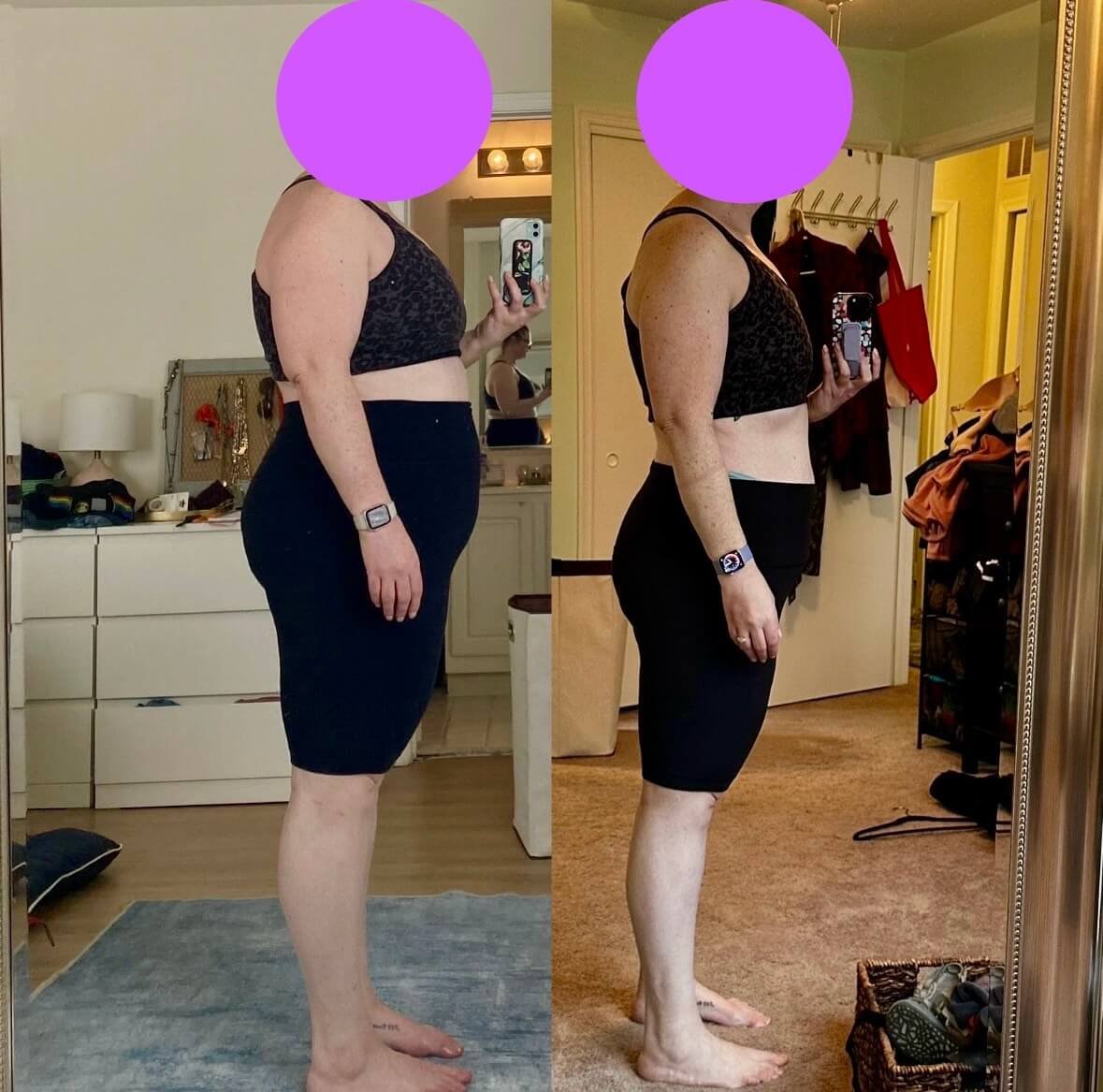How to Measure Progress Without the Scale
While on a weight loss journey, the scale is the only tool or measure, but it’s often not the most helpful. Sometimes the number on the scale can be misleading or discouraging, especially if you’re doing everything “perfectly” and not seeing the results you desire. At the end of the day, the scale is only one tool, but there are many other powerful ways to measure progress.
Are you asking yourself, “How do I measure weight loss without a scale?” If so, know that you’re not alone! This article will walk you through how to tell if you’re losing weight without a scale, and how to stay consistent with your actions (and results) using non-scale methods. We will also cover why the scale isn’t always the best indicator of progress, as well as various strategies you can use to measure progress that have nothing to do with the bathroom scale. Let’s dive in!
Why the Scale Isn’t Always the Best Indicator of Progress
Many of us have been brought up to believe that the bathroom scale is the #1 indicator of progress while on a weight loss journey. However, there are many other factors that influence the number on the scale. Some of these factors include water retention, inflammation, hormones, muscle gain, recovery from a challenging workout, and salt intake.
At the end of the day, the number on the scale does not measure body composition or how you’re thinking about food and your body (aka your mindset). Also, keep in mind that weight loss is not necessarily the same as fat loss. While in a calorie deficit, you *could* be losing lean muscle mass instead of body fat (which no one wants!) This is why strength training is so important to your fitness routine!
Real-Life Example of Losing Weight Without a Scale
Before moving forward, I want to share the story of one of our past Strong with Sarah clients. After losing and gaining the same 20 pounds time and time again, Lucy* came to us wanting to lose weight and tone up, once and for all. My team and I helped her create a moderate calorie deficit, and she began doing strength training with Coach Victoria through our coaching app.
Over the course of our 8-month journey together, Lucy only “lost” 6 pounds. However, because she was losing body fat while gaining some lean muscle (to appear more toned and fit), she lost a total of 17 inches off her waist, hips, and chest measurements. In other words, she was able to drop 2 pant sizes and 1 size in her shirts because she changed her body composition (less body fat and more lean muscle). The number on the scale didn’t necessarily reflect her progress or the change in body fat and lean muscle, but it was very noticeable in her results and in her progress photos.
How Do I Tell If I am Losing Weight Without a Scale?
While on a weight loss journey, there are many other ways to measure your progress aside from the scale. Let’s dive into the details and cover other ways to track your progress:
📸 Use Progress Photos to Visually Track Changes
Many times, our eyes see what the scale cannot. Plus, it’s empowering to visually see the progress you’re making over time. Progress photos allow you to notice visual changes to your posture, appearance, and muscle definition. Especially if you are someone like Lucy* (that I mentioned earlier) who is prioritizing strength training while in a calorie deficit, you may be losing body fat and gaining lean muscle. In other words, progress photos often track body composition changes better than the scale alone.
*Name has been changed to respect client’s anonymity
Want to see more progress photos?
Here’s how to accurately take progress photos:
First, choose an outfit to wear that is form-fitted, but you are comfortable in. I often recommend swimsuits, fitted shorts, tanks, sports bras with shorts, etc. Wear the same outfit each time you update your progress photos.
Be sure to use good lighting for your photos, and if possible, take photos in the same place so that the only changes you’re truly aware of are the ones on your body.
Use a tripod or prop your phone up on a book on a table so you can see your entire body in the photos.
Take photos from the front, side, and back.
📷 I recommend updating your progress photos every 3-6 weeks while on a weight loss journey.
📏 Track Circumference Measurements for a More Accurate Picture
As we’ve already mentioned, there are many factors that affect your weight. While things like hormones, hydration, food in our intestines, etc., affect the number on the scale, they don’t tend to affect circumference measurements.
In fact, according to Healthline, using measurements to estimate body fat percentage is better than using the scale alone. In other words, using measurements is one of the most effective ways to track weight loss without a scale.
If you choose to use measurements to track progress, I recommend keeping track of your waist, hips, and chest/bust at a minimum. You can also add arm measurements, thigh measurements, neck circumference, or any other measurements.
At Strong with Sarah, we notice that clients sometimes drop inches quicker than they do pounds – which is normal! Again, this is a sign that you’re losing body fat while gaining lean muscle.
Here’s how to accurately take measurements:
When it comes to measurements, consistency is key! Use a body marker (such as your belly button or a mole) as the place to measure, or use a ruler to accurately keep measurements consistent over time (for example, measure 3 inches above your kneecap for the thigh circumference.
On top of measuring the exact same spot, complete measurements at the same time of day. Usually first thing in the morning, after using the restroom but before eating or drinking anything, is best for most people.
📏 I recommend updating your measurements once per month.
👗 Pay Attention to How Clothing Fits
Jeans, work pants, bras, fitted shorts, or your favorite dresses don’t lie. How your clothing fits probably provides a better indicator of how happy and confident you are on your health journey, regardless of the number on the scale. Similar to measurements, factors like hormones, water retention, or food in our GI system don’t seem to affect how our clothes fit.
I encourage you to find an article of clothing that you love and call it your “goal clothes.” Maybe it’s a dress you used to wear that doesn’t fit anymore, or a swimsuit you’ve always wanted to feel confident about wearing.
Start to notice when clothes fit looser and/or are more comfortable – that’s when the real progress happens!
⚡️ Monitor Strength and Energy Levels
Physical improvements to daily life aren’t something that can be measured using a bathroom scale. For example, being able to complete more reps or lift heavier weights during workouts, or not feeling so winded when walking up and down stairs, or having the energy to live and enjoy your life without needing that afternoon coffee are all massive signs of progress that can’t be measured solely by your weight.
Even if your weight hasn’t changed, simply feeling better and noticing positive changes in your workouts is a sign that your body composition is changing.
☝️ One of our clients recently experienced a plateau on the scale where her weight didn’t change for 3 weeks, but during that time she was able to run 1 mile without stopping for the first time in her adult life!
Ask yourself the following questions to start noticing your strength and energy levels:
“Are my workouts feeling easier?”
“How do I feel as I live my daily life?”
“How quickly am I recovering after my workouts? Am I sore for days or feeling better quicker?”
☮️ Track Mood, Thoughts, Confidence, and Sleep Quality
There’s more to weight loss than just your physical appearance. Better sleep, more confidence, and feeling better mentally are all signs of internal progress while on a weight loss journey. These are all results that you don’t “see” on the scale, but that you notice by simply living and enjoying life.
Here are some examples of these types of progress markers:
Feeling more rested when you wake up in the morning
Fewer energy crashes throughout the day
Easier time being able to focus on the task at hand
Feeling less anxiety around food or having less “food noise”
Being in a better mood more often
The Power of Non-Scale Victories
Before finishing up, I want to highlight something called Non-Scale Victories. These “wins” are moments that you experience throughout life where you notice the effects of the health changes you’ve made, that have nothing to do with the bathroom scale.
Here are some common examples of non-scale victories:
🚲 Enjoying a bike ride or hike with your family without feeling overly winded
👧🏻 Being able to play with your kids and grandkids
🏝️ Feeling confident and energized while on vacation
📸 Feeling good when you see photos of yourself
Non-Scale victories are signs of sustainable lifestyle changes, which is the ultimate goal. These wins might not show up on the scale — but they’re often the ones that last the longest.
Final Thoughts: How to Measure Weight Loss Without a Scale
If there’s one thing I hope you take away from this article, it’s this: your progress is about so much more than the number on the scale. The work you’re doing — fueling your body with healthy foods, moving consistently, gaining strength, shifting your mindset — it all counts. Whether it shows up as looser jeans, better sleep, more energy, or simply feeling more confident in your skin, it matters.
So if you’ve ever stared down at the scale and felt defeated, know that you’re not alone — and there’s a better way. You can make sustainable progress, and you don’t have to do it by yourself.
At Strong with Sarah, we specialize in helping our clients ditch the all-or-nothing mindset and create lasting change through realistic, non-restrictive coaching. If you're ready to feel strong, confident, and in control of your health — without obsessing over the scale — we’re here for you.




